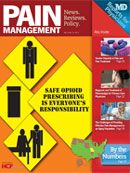Publication
Article
Pain Management
Report Shows a Large Increase in the Number of Americans Treated for Prescription Painkiller Abuse and Addiction
Federal report underscores recent data showing surge in the abuse and misuse of prescription opioids, especially among adolescents
The “Treatment Episode Data Set 1999 — 2009,” (http://hcp.lv/lCubxc) recently released by the Substance Abuse and Mental Health Services Administration (SAMHSA), provides “information on the demographic and substance abuse characteristics of admissions to treatment aged 12 and older for abuse of alcohol and/or drugs in facilities that report to individual State administrative data systems.” The data in the report reveals several unfavorable trends in the increasing misuse and abuse of prescription opioids:
- Opiates other than heroin “increased from 1 percent of admissions aged 12 and older in 1999 to 7 percent in 2009. Opiates other than heroin represented 8 percent of all opiate admissions in 1999 but rose to 33 percent in 2009.”
- Opiates other than heroin “represented 11 percent of adolescent opiate admissions in 1999 but rose to 65 percent in 2009.”
- Opiates other than heroin “were reported as the primary substance of abuse for 7 percent of TEDS admissions aged 12 and older in 2009… These drugs include meth adone, co-deine, hydrocodone, hydromorphone, meperidine, morphine, opium, oxycodone, pentazocine, pro poxyphene, tramadol, and any other drug with morphine-like effects.”
In a statement that accompanied the release of the report, SAMHSA Administrator Pamela S. Hyde, JD, said that this data “shows the challenge our nation’s health system must address as the treatment needs of people with drug and alcohol problems continue to evolve.” Gil Kerlikowske, Director of National Drug Control Policy, said that the report “underscores the severity of our nation’s prescription drug abuse epidemic and the importance of public awareness regarding the harms caused by drug use” and reiterated that all health care professionals “share the responsibility to address our Nation’s drug problem by working collaboratively at the Federal, state, and local level to prevent drug use before it starts, expand access to drug treatment, and support enforcement efforts that disrupt the diversion of prescription drugs” (http://hcp.lv/mJtF7c).
Physicians tell Congress what to do
Physicians from the American Society of Interventional Pain Physicians (ASIPP) and the North American Neuromodulation Society recently went to Washington, DC, to convince lawmakers to support legislation that would require all physicians who wish to prescribe opioids and other controlled substances to undergo mandatory training to learn about safe prescribing practices and how to identify and provide care for potential addicts. PBS Newshour (http://hcp. lv/mniy83) reported that the physicians asked Congress to support the Prescription Drug Abuse and Prevention Act of 2011 introduced in early March by Senator Jay Rockefeller (read more about this bill at http://hcp.lv/iyQjXb). They also called for support of HR 1925, the House counterpart to this bill (http://hcp.lv/lNQwHK), which also calls for prescribers to undergo 16 hours of training every three years focusing on treatment and management of opioiddependent patients, pain management treatment guidelines, and early detection of opioid addiction.
The National All Schedules Prescription Electronic Reporting Reauthorization Act of 2011 (http://hcp.lv/iJ3SN7) and the Ryan Creedon Act of 2011 (http://hcp.lv/ ipqN6Q) were also singled out for praise by the ASIPP physicians. The Ryan Creedon Act would require clinicians who are registering or renewing their registration to prescribe or dispense schedule II-V controlled substances to “obtain particular training or special certification, approved by the Attorney General, on addiction to and abuse of controlled substances and appropriate and safe use of controlled substances.” The Secretary of Health and Human Services (in consultation with the Attorney General) would determine the standards and requirements of this education, which would be provided by medical societies, state medical licensing boards, accredited continuing education providers, or other entities as determined by the HHS Secretary.
ASIPP spokesperson David Kloth, MD, told Newshour that “In most cases, doctors contribute innocently because they haven’t been trained properly on how to prescribe in a responsible way, how to identify a drug addict and help them,” and estimated that up to 90% of physicians in the US “have absolutely no training or education in the use of controlled substances.” Kloth said that tying training to licensure or DEA registration is the only option at this point because he thinks that “Physicians won’t do this voluntarily. If we don’t have this in some way required, we won’t be able to solve this problem fully.” Read the complete interview (http://hcp.lv/mniy83) for more of Kloth’s thoughts on the causes of and potential solutions to the prescription opioid addiction epidemic.






